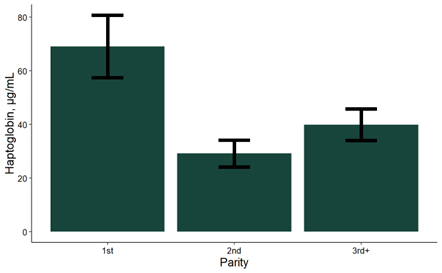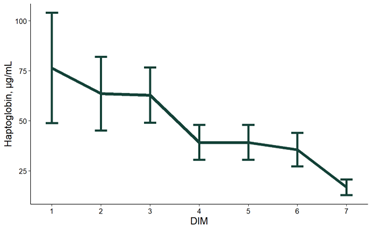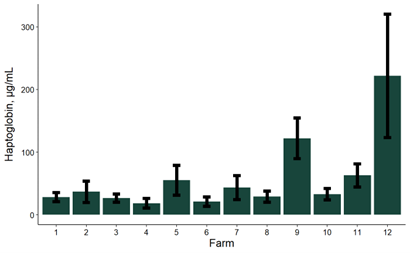Research Drilldown - Inflammation after calving: a hidden drag on your herd?
Cows with greater inflammation after calving produce less milk, take longer to get pregnant, and are at greater risk of leaving the herd. Is this a problem in Michigan? Let’s dig into what is and isn’t known about this timely topic.

The health of dairy cows after calving is important for productivity and fertility during the remainder of their lactation – that is not news to most of us. Research has shown time and again that cows with greater inflammation after calving produce less milk, take longer to get pregnant, and are at greater risk of leaving the herd than their less-inflamed herdmates.
Is this a problem in Michigan? Let’s dig into what is and isn’t known about this timely topic.
What is inflammation and how is it assessed?
Most everyone is familiar with the concept of inflammation. When our immune system recognizes signs of infection or tissue trauma, responses are activated which result in some telltale signs of inflammation: redness, swelling, pain, and fever. This describes what we refer to as acute or clinical inflammation, which can be diagnosed easily enough with a physical examination of a cow (or self-diagnosed when you roll out of bed in the morning).
As the study of immunology has advanced, though, more subtle forms of inflammation have been described. There are situations where the clinical signs of inflammation are absent but the internal signals that drive inflammation are clearly activated, a condition that we refer to as subclinical inflammation. In human medicine, this can result in a doctor calling a patient back in for more testing after a routine annual appointment reveals a blood marker that is “out of bounds”.
Studies from around the world over the last 20 years have shown that several blood markers linked to inflammation are typically increased – sometimes by as much as 10,000-fold – in cows during the first week after calving. The most commonly used blood marker in cattle is a protein called haptoglobin, which is produced and released by the liver when it encounters inflammatory signals. As in humans, an elevated blood marker doesn’t necessarily mean that a cow is desperately sick, but it does indicate that an unusual internal process is occurring, worthy of further investigation.
Is this relevant to dairy managers?
One experiment found that cows with abnormally elevated blood haptoglobin after calving produced 1,000 lb less milk over their lactation compared to herdmates with more normal haptoglobin concentrations. At current milk prices, that equates to roughly $200 less revenue from those cows. On a 1,000-cow dairy farm where 30% of cows experience greater levels of inflammation, a farm could expect to lose $60,000 of milk revenue in a year. This price tag does not account for the costs associated with reduced fertility and increased culling of cows with excessive inflammation after calving. Clearly, excessive inflammation can hurt dairy profitability.
The difficult part of the inflammation problem is how to address it. Inflammation during and after the calving process is necessary, so we do not want to shut it down entirely – we want to promote a proper and rapid resolution of the inflammation that naturally occurs. Some research has investigated feed additives and drugs that may help manage inflammation during the transition period. However, it’s also important to ask whether some management factors put cows at risk for excessive or chronic inflammation.
With funding from the Michigan Alliance for Animal Agriculture, we’re collaborating with a team of scientists to address the following questions:
- What does inflammation look like on commercial dairy farms in Michigan?
- Does the degree of inflammation vary from farm to farm?
- What management strategies are associated with post-calving inflammation on Michigan dairy farms?
Research at MSU
To begin to address these questions, we have been collecting blood samples from cows in their first week of lactation on dairy farms throughout Michigan. So far, we have collected blood from 418 cows across 12 Michigan dairies for analysis of haptoglobin.
Other researchers have already demonstrated that the post-calving period is associated with less milk, poorer fertility, and increased risk of leaving the herd during that lactation. Our goal is to expand on this research to determine if there are management factors at the herd level that are associated with inflammation in dairy cows. If we can isolate certain factors or decisions that may be linked to inflammation, then we can devise management strategies with the goal of reducing inflammation and improving cow health.
We are still in the early stages of this work, but we’ve already found some interesting patterns in the data that provide insights into post-calving inflammation.
1) First lactation cows have much greater haptoglobin concentrations than older cows do
This probably is not all that surprising, as these samples come after calving and younger cows often experience more difficulty while giving birth. But it is surprising how large the difference is – first lactation cows have more than twice the haptoglobin concentrations of multiparous cows, on average (Figure 1). This suggests that first parity cows may experience greater physiological stress than older cows at this time, even though their risk for common transition disorders is less. Research in other species has shown that haptoglobin and other similar blood markers of inflammation can be increased by anxiety caused by stressful surroundings or regrouping, and perhaps the novelty of experiencing lactation cow management (regrouping, parlor visits, older cow dominance) contributes to high haptoglobin in first lactation cows.

We are not able to isolate specific factors that contribute to this elevated level of inflammation with certainty, but our observations support some best practices in managing heifers in the transition period. If infrastructure allows, separating heifers from mature cows during the pre- and post-calving periods may help them adapt more readily. In mixed-parity housing, younger cows are more often displaced from the feedbunk and freestalls than older cows, and the problem is likely exacerbated when transition cows are stocked more densely. Among other issues, inflammation can decrease the drive to eat, and a heifer with high inflammatory signals who is being repeatedly pushed away from the feedbunk may be more susceptible to inadequate feed intake, which promotes metabolic disease and hurts productivity. It also may be helpful to limit pen moves during this period, as these moves increase the social stress that cows face. To help heifers adapt even better to the new conditions after calving, some farms run close-up heifers through the parlor once per day or use training robots (on farms with automated milking systems) to limit the stress of encountering these new environments for the first time right after calving, when physiological stress is also peaking. In general, consider strategies that minimize the stress young cows experience during this time around calving.
2) Inflammation is greatest right after calving and slowly declines over the first week of lactation
Blood haptoglobin concentrations are greatest in the first 3 days after calving, but they are also the most variable in these days, which indicates that some cows have much greater inflammation right after calving than others. This leads to questions about whether there is any practical means to identify those cows with the greatest degree of inflammation in the day or two after calving, so that they can receive additional support. Unfortunately, as of now, no quick and inexpensive method for identifying these cows has been discovered.
The good news is Figure 2 also demonstrates that the great majority of cows begin to resolve the inflammation in the first week of lactation. Resolution of inflammation refers to the process of downregulating the inflammatory signals and reversing the physiological responses to inflammation. This resolution process is likely important for allowing cows to increase feed intake, initiate a healthy uterine regression process, and hit targets for peak milk production.

Even if we can’t practically identify cows with excessive inflammation and intervene individually, there may be ways that we can support the resolution process in all cows, and this is part of the reason for our focus on herd-level assessment in the study. At the herd level, there is evidence that some feed additives, such as omega-3 fatty acids and plant polyphenol sources, can reduce some signs of inflammation in transition cows. For example, one study carried out by our group showed that supplementing cows with an extract from a plant called Chinese skullcap for the first 60 days in milk reduced somatic cell count and increased milk yield by about 13% over the entire lactation.
There are basic management practices that likely aid in the resolution process as well, including maintaining limited stocking density in fresh pens, limiting time out of the pen for milking, cooling dry and fresh cows adequately in the summer, and ensuring consistent access to feed and water. Although it has not been tested, using an individualized approach to “graduating” from a fresh pen may also support more consistent resolution of early lactation inflammation. Through a combination of visual gut fill assessment and cow monitoring technology, cows that are eating adequately by day 10 of lactation may be ready to move to a peak lactation or breeding pen, where nutrient supply is generally greater than in the fresh pen.
On the other hand, cows that are lagging in feed intake, had experienced dystocia, calved in with high body condition, or show signs of any disorder can be retained in a fresh pen for longer. This allows the valuable fresh pen space (and potentially expensive fresh pen feed additives) to be utilized for those cows that need the most support to “get over the hump” and progress to a successful lactation.
3) Some farms have cows with much greater inflammation than others
The most interesting finding from our preliminary analysis is that there is great variability in the average level of post-calving inflammation across dairy farms. Our goal is to investigate why farms, like 9 and 12 in Figure 3, have cows with greater average concentrations of haptoglobin. These farms share some common management practices that result in cows with greater inflammation after calving? Identifying such management strategies or characteristics will provide dairy farmers with more information about which strategies are optimal for cow health and productivity.

We will also have samples collected throughout the year, which will help us establish how seasonality may impact the inflammatory status of dairy cattle. Although we do not have concrete answers to these questions yet, we are working toward them with MSU collaborators (Drs. Annette O’Connor and Angel Abuelo) as well as collaborators at Iowa State University (Dr. Gail Carpenter) and Purdue University (Dr. Rafael Neves).
Interested in participating in our experiment?
To address our core questions, we plan to work with at least 40 Michigan farms in this experiment, with 40 to 80 cows sampled from each farm (more than 2,000 cows in total). If you’re interested in participating in our experiment, please reach out to Barry Bradford at bjbrad@msu.edu. Greater numbers of farms and cows in our experiment give us more power to generate insights and concrete recommendations to support healthier, more sustainable dairy herds.
What to remember?
Inflammation is a necessary part of the calving process, but ideally this inflammation is limited and resolves quickly, which allows the cow to get her lactation off to a strong start. Excessive inflammation has a great economic cost due to lost milk revenue, increased disease incidence, and reduced fertility. Haptoglobin, a blood marker of inflammation, is greatest in 1st parity cows and right after calving. Most interesting to us is that there is great variation in fresh cow inflammation across Michigan dairy farms, and we think that management factors may be contributing to this variation. As we continue asking these questions, producers have the opportunity to critically evaluate pre- and post-calving management, nutrition, and health programs to identify bottlenecks that may be making it harder for their cows to resolve inflammation after calving.



 Print
Print Email
Email





